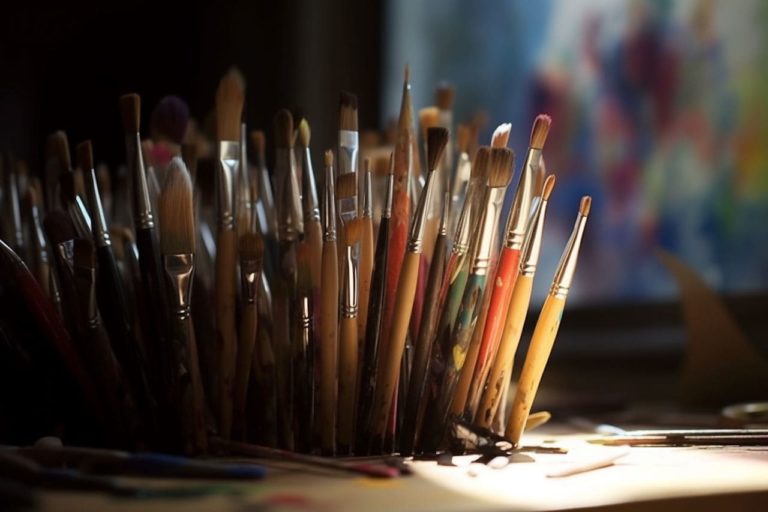As an artist, choosing the right paintbrush can be a daunting task. There are so many shapes, sizes, and materials to consider. It can be overwhelming, but fear not! We’re here to help you navigate the world of paintbrushes.
First things first: let’s talk about the different parts of a paintbrush. The bristles are the most important part, as they are responsible for holding and distributing the paint. The ferrule is the metal part that connects the bristles to the handle, and the handle is, well, the part you hold onto.
Brush Shapes
Now, let’s talk about brush shapes. The shape of a brush determines its primary function. Here are some of the most common brush shapes and their uses:
- Round: A round brush is circular in shape and has a pointed tip. It is versatile and can be used for everything from fine details to broad strokes.
- Flat: A flat brush has a square-shaped end and is ideal for making straight, crisp lines.
- Filbert: A filbert brush has an oval-shaped end and is great for blending and creating soft edges.
- Fan: A fan brush is shaped like a fan and is used for blending and creating textures.
- Angular: An angular brush has a slanted edge and is ideal for creating sharp, angled lines.
Brush Sizes
The size of a brush refers to the length and width of its bristles. Smaller brushes are typically used for fine details, while larger brushes are used for broader strokes. Here are some common brush sizes and their uses:
- 00-0: These brushes are very small and are used for fine details and precision work.
- 1-2: These brushes are slightly larger than the 00-0 size and can be used for finer details as well as small areas.
- 3-6: These brushes are medium-sized and are good for larger details and broader strokes.
- 7-10: These brushes are large and are used for broader strokes and large areas.
Brush Materials
The material a brush is made of can greatly affect its performance. Here are some common brush materials and their characteristics:
- Natural Bristles: Natural bristle brushes are made from animal hair (usually hog or sable). They are great for oil and acrylic painting and hold more paint than synthetic brushes. However, they can be more expensive and require more care.
- Synthetic Bristles: Synthetic brushes are made from nylon or polyester and are less expensive than natural bristle brushes. They are great for watercolor and acrylic painting, as they can hold their shape and are easier to clean.
- Sable Hair: Sable hair brushes are made from the hair of a sable (a type of weasel). They are soft and hold a lot of paint, making them ideal for watercolor and delicate work.
- Hog Bristle: Hog bristle brushes are made from the hair of a hog. They are stiff and durable, making them ideal for heavy-bodied paints like oil.
Choosing the Right Brush for the Job
Now that you know the basics of brush shapes, sizes, and materials, it’s time to choose the right brush for the job. Here are some tips to help you make the right choice:
- Consider the type of paint you’re using: Different paints require different types of brushes. For example, oil paints require natural bristle brushes, while watercolors require softer synthetic or sable hair brushes.
- Think about the size of the painting: The size of your painting will also determine the size of the brush you need. For larger paintings, you’ll need larger brushes to cover more area
- Consider the level of detail: If you’re working on a painting with fine details, you’ll need a smaller brush. A larger brush is better for broad strokes and background work.
- Consider the texture of the paint: The texture of the paint you’re using can also affect the brush you choose. For thicker, heavier paints like oil, you’ll want a stiffer brush. For thinner, lighter paints like watercolor, you’ll want a softer brush.
Caring for Your Brushes
Once you’ve chosen the right brushes for your project, it’s important to take care of them properly. Here are some tips for cleaning and storing your brushes:
- Clean your brushes after each use: To clean your brushes, rinse them under warm water and use a gentle soap to remove any paint. Be sure to reshape the bristles before laying them flat to dry.
- Store your brushes properly: Store your brushes with the bristles facing up or in a brush holder to prevent damage to the bristles.
- Avoid leaving brushes in water: Leaving your brushes in water for extended periods of time can damage the bristles and ruin the shape of the brush.
Conclusion
Choosing the right paintbrush can make all the difference in your artwork. By considering the shape, size, and material of your brushes, you can create beautiful works of art with ease. And by taking care of your brushes properly, you can ensure that they last for many projects to come.
Remember, practice makes perfect! The more you experiment with different brushes and techniques, the better you’ll become at choosing the right brush for the job.
So go ahead, grab your brushes, and start creating your masterpiece!
